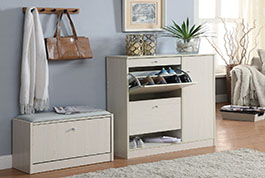Views: 87 Author: Site Editor Publish Time: 2021-05-01 Origin: Site

Like other furniture, the history of the hanger extends from ancient to modern. Hangers can hold up many precious garments and store them in crowded living spaces. Nowadays, there are various kinds of hangers, such as common wall coat hanger, oak coat rack and metal coat hooks. Have you ever learned about the original source of the hanger? Who invented this humble little device in the first place?
There are many types of drying racks, and several common types are introduced below.
1. Balcony lift type
Balcony lift-type drying rack is installed on the balcony, and the drying rod is lowered by hand or electric method, and after the clothes are dried, the drying rod is raised. This product is suitable for use on the balcony of homes and dormitories.
2. Wall-mounted type
The wall-mounted drying rack is installed on the wall, and the installation height is generally up to a person's chest. Wall mounted cloth hanger and wall mounted coat rack with hooks are usually put down against the wall and do not take up space. These drying racks are short and suitable for hotels, dormitories, hospital wards, family rooms, etc. The long ones are suitable for outdoor use, such as villas or houses with yards.
3. Floor type
Floor-standing drying racks are a kind of drying racks that are used directly on the ground. At present, X-shaped, butterfly-shaped (also known as wing-shaped), horizontal and parallel bars are common. The standing coat rack and vertical coat rack are suitable for rooms, balconies and outdoors.
4. Stretching
Stretching racks are also installed on the wall. This kind of hanger can be pushed close to the wall at ordinary times, and stretched out to hang clothes during use. Wall mounted hook rack and folding coat rack are suitable for rooms, balconies and outdoors.
No matter how many types of drying racks there are, its main function is to dry clothes. Everyone should focus on practicality and economy when buying.
The wire drying rack we use today is inspired by the 1869 patent for the clothes hook designed by O. A. in Northern England, Connecticut, USA. Albert J. Parkhouse invented the drying rack in 1903 because employees complained about too few hooks. He folded a piece of wire into two opposing ellipses and folded the end of the wire into a hook shape. Parkhouse applied for a patent for this, but we still don't know whether he will profit from it.
Schuyler C. Hulett received a patent for an improved drying rack in 1932. He put hoses on the upper and lower parts of the hanger so that he could prevent the newly washed clothes from being crumpled by the hanger.
Three years later, Elmer D Rogers invented the extendable drying rack that we have been using now. At that time, he was a blacksmith who made lampshades for a wire and small handmade products company in Michigan. One day he found out angrily that the coat hooks in the cloakroom of the factory were all occupied. He angrily took out a piece of lead wire, bent it into the shape of the shoulder of the coat and added a hook on it. This invention was claimed by his boss and obtained a patent. This is the origin of the hanger.
Nowadays, the types of hangers are becoming more and more diversified. The simple contemporary coat rack is my personal preference.
The company (Wenzhou Zhongwang Hardware Co., Ltd.) has hangers and hooks in various styles and materials. Log in to the official website below for more product information.


